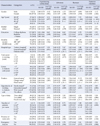Abstract
Purpose
The aim of this study was to investigate the relationships between the hemodialysis unit nurses' experience of verbal abuse, job stress, burnout, and turnover intention, and to identify the explained variances for turnover intention.
Methods
The research design was a descriptive survey using a probability sampling. The data were measured using self-report questionnaires from 231 hemodialysis unit nurses in seven cities in Korea and were analyzed with SPSS 20.0.
Results
The mean scores were 2.45±0.62 (out of 5) for experience of verbal abuse, 2.40±0.26 (out of 4) for job stress, 2.31±0.48 (out of 4) for burnout, and 3.16±0.05 (out of 5) for turnover intention. There were significant correlations among the experience of verbal abuse, job stress, burnout, and turnover intention within the hemodialysis unit nurses. Factors influencing turnover intention were 'burnout' (β=.42, p<.001) and 'job stress' (β=.17, p=.015)which explained 42% of the variance (F=15.98, p<.001).
Figures and Tables
Table 1
Differences in Experience of Verbal Abuse, Job Stress, Burnout and Turnover Intention by Participants' Characteristics (N=231)

References
1. ESRD Registry Committee. Korean Society Nephrology. Current renal replacement therapy in Korea: Insan memorial dialysis registry, 2013 [Internet]. Seoul: Korean Society Nephrology;2013. cited 2014 August 20. Available from: http://www.ksn.or.kr/journal/2014/index.html.
2. Danquah FV, Zimmerman L, Diamond PM, Meininger J, Bergstrom N. Frequency, severity, and distress of dialysisrelated symptoms reported by patients on hemodialysis. Nephrol Nurs J. 2010; 37(6):627–639.
3. Erdenen F, Curuk S, Karsidag C, Muderrisoglu C, Besler M, Trabulus S, et al. Evaluation of disability, anxiety and depression in hemodialysis patients. Nobel Med. 2010; 6(1):39–44.
4. Yeom EY, Kim MY. The 'Good Nursing' experienced by hemodialysis patients. Korean J Adult Nurs. 2014; 26(3):275–286. DOI: 10.7475/kjan.2014.26.3.275.
5. Korean Nephrology Nurses' Association. Register status [Internet]. Seoul: Korean Nephrology Nurses' Association;2014. cited 2014 September 9. Available from: http://www.knna.or.kr/knna/community/knna_community.php.
6. Park EJ, Kim YH. A grounded theory-based approach to practice adaptation process of hemodialysis unit nurses. J Korean Acad Nurs Adm. 2013; 19(1):128–137. DOI: 10.11111/jkana.2013.19.1.128.
7. Health Insurance Review & Assessment Services. Where are the best hospitals doing hemodialysis? [Internet]. Seoul: Health Insurance Review & Assessment Services;2013. cited 2014 September 20. Available from: http://www.hira.or.kr/rd/hosp/getHospList.do?pgmid=HIRAA030002000000.
8. Dermody K, Bennett PN. Nurse stress in hospital and satellite haemodialysis units. J Ren Care. 2008; 34(1):28–32. DOI: 10.1111/j.1755-6686.2008.00007.x.
9. Hur YJ, Lee BS. Relationship between empowerment, job stress and burnout of nurses in hemodialysis units. Keimyung J Nurs Sci. 2011; 15(1):21–30.
10. Lee YL, Ahn SH. Impact of job stress on turnover intention among emergency room nurses. J Muscle Joint Health. 2015; 22(1):30–39. http://www.dbpia.co.kr/Article/NODE06277233.
11. Yoon GS, Kim SY. Influences of job stress and burnout on turnover intention of nurses. J Korean Acad Nurs Adm. 2010; 16(4):507–516. DOI: 10.11111/jkana.2010.16.4.507.
12. Bang BM, Lee SY, Cheong JO. Empirical study on the turn-over intention of university hospital nurses. J Digit Converg. 2015; 13(2):205–213. DOI: 10.14400/JDC.2015.13.2.205.
13. Aiken LH, Clarke SP, Sloane DM, Sochalski J, Silber JH. Hospital nurse staffing and patient mortality, nurse burnout, and job dissatisfaction. JAMA. 2002; 288(16):1987–1993. DOI: 10.1001/jama.288.16.198.
14. Murphy F. Stress among nephrology nurses in Northern Ireland. Nephrol Nurs J. 2004; 31(4):423–431.
15. Kim SJ. The phenomenological study on a ethical dilemma of
hemodialysis nurse [master's thesis]. Seoul: Ewha Women University;2006.
16. Buback D. Assertiveness training to prevent verbal abuse in the OR. AORN J. 2004; 79(1):148–150. 153–158. 161–164. quiz 165-166quiz 169-170DOI: 10.1016/S0001-2092(06)61149-6.
17. Nam KD, Yoon GS, Jeong HS, Park SA, Jang BY, Kim HR, et al. Study on the development of verbal abuse scale for operating room nurses. J Korean Acad Nurs Adm. 2005; 11(2):159–172.
18. Yoo MO. Influences of verbal abuse on job stress and organizational commitment of nurses [master's thesis]. Chungju: Chungju University;2012.
19. Chang SJ, Koh SB, Kang D, Kim SA, Kang MG, Lee CG, et al. Developing an occupational stress scale for Korean employees. Korean J Occup Environ Med. 2005; 17(4):297–317.
20. Malakh-Pines A, Aronson E, Kafry D. Burnout: from tedium to personal growth. New York: Free Press;1981.
21. Hong GP. Analytic study on burnout in relation with personal and job related characteristics and social support [dissertation]. Seoul: Yonsei University;1985.
22. Lawler EE. Satisfaction and behavior. In : Hackman JR, Lawler EE, Porter LW, editors. Perspectives on behavior in organizations. 2nd ed. New York: McGraw-Hill;1983. p. 78–97.
23. Park HS. Relationship between perceived nursing care role orientation, job characteristics and turnover among nurses [master's thesis]. Seoul: Yonsei University;2002.
24. Choi MK. Study among verbal abuse, burnout, organizational commitment in nurses working in acute hospital [master's thesis]. Asan: Soonchunhyang University;2014.
25. Lee HB, Jong HY, Han DC. Dialysis nurse's burnout. Korean J Nephrol. 1989; 8(4):53–56.
26. Kim KS, Lee HR. Comparative study on the stress and the coping method between nephrology nurses working in the hospitals of university and the hemodialysis clinics. J East West Nurs Res. 2004; 9(1):46–56.
27. Yoon SH. Occupational stress and depression in clinical nursesusing Korean occupational stress scales. J Korean Acad Nurs Adm. 2009; 15(3):463–470.
28. Kim MS, Sin MJ, Kim MK, Kim JH, Park SM, Woo HJ, et al. A study on the job activity analysis of the hemodialysis nurses. J Korean Acad Nurs Adm. 2000; 6(3):303–317.
29. Park SM, Jang IS, Choi JS. Affecting factors of nurses' burnout in secondary general hospitals. J Korean Acad Nurs Adm. 2011; 17(4):474–483. DOI: 10.11111/jkana.2011.17.4.474.
30. Kang KN. Factors influencing turnover intention of nurses in small-medium sized hospitals. J Korean Acad Nurs Adm. 2012; 18(2):155–165. DOI: 10.11111/jkana.2012.18.2.155.




 PDF
PDF ePub
ePub Citation
Citation Print
Print





 XML Download
XML Download